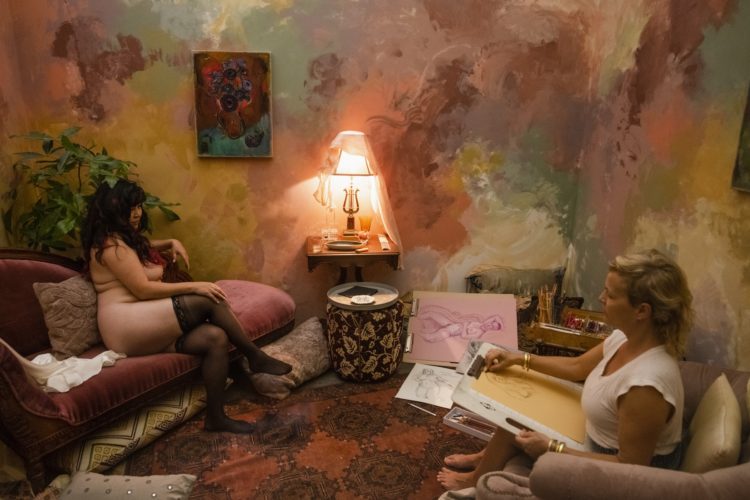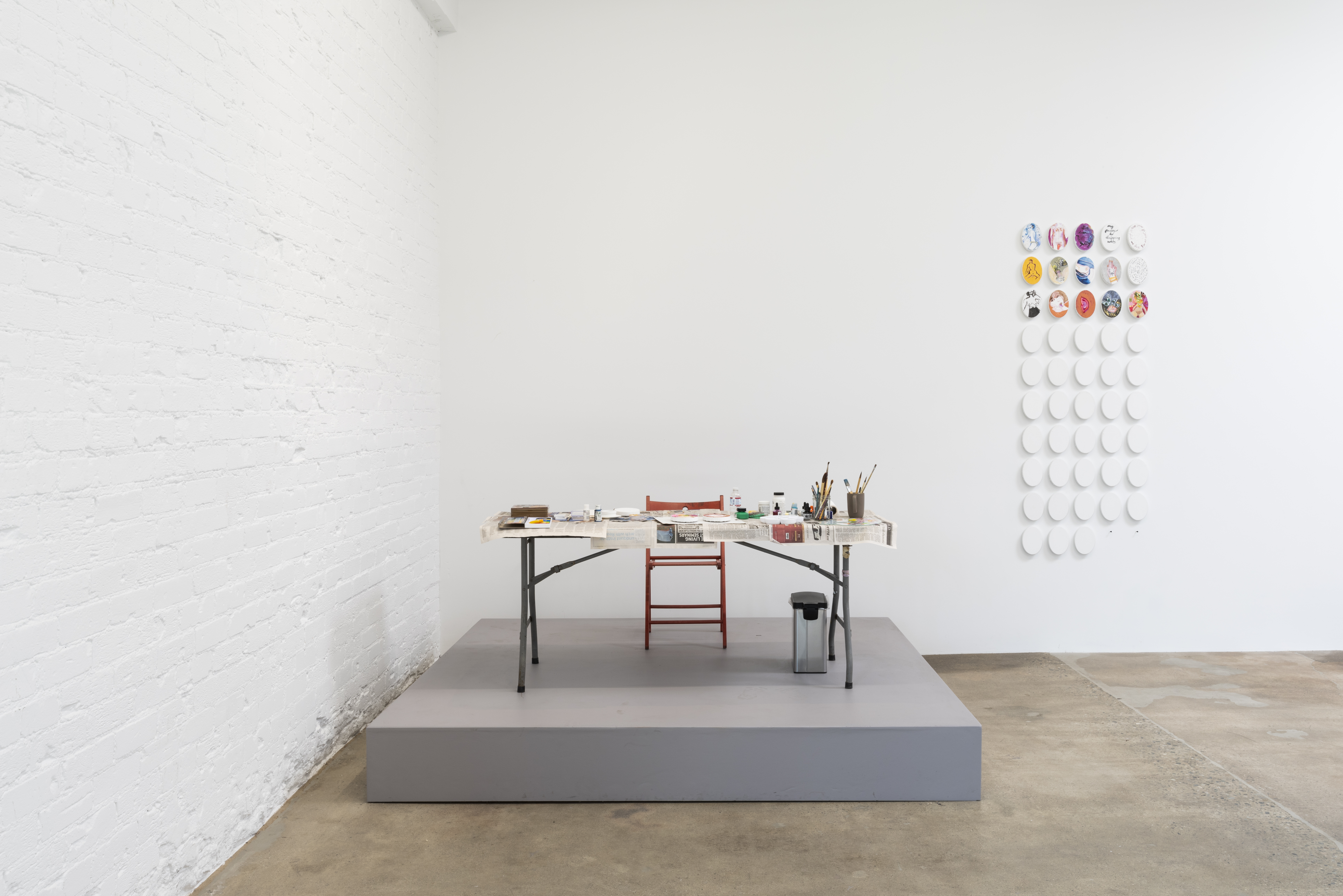The Art of Porn: Pornhub and Maccarone Present “The Pleasure Principle”


There is no denying that the relationship between art and sexual imagery is as longstanding as the history of art itself. Nude figures in varying degrees of censorship have been consistently depicted even as styles and tastes have changed throughout the centuries. Even ancient Rome saw the production of erotic sculptures, frescoes, and mosaics. How these forms of art became defined as art and not porn is the underlying question in the current exhibition “The Pleasure Principle” at Maccarone in Los Angeles. Featuring well-known female artists, including Lynda Benglis, Louise Bourgeois, Tracey Emin, and Laurie Simmons the exhibition that is fully funded by the porn giant, Pornhub, blurs the boundaries between art and porn by recontextualizing porn in the setting of an art gallery.
The obvious question when considering Pornhub’s collaboration with Maccarone is, why? Why would Pornhub spend the money to commission a large-scale art exhibition? And why would Maccarone agree to it? The answer for Pornhub seems to be related to a larger cultural program that the company has been promoting in recent years: “I think it’s important to get involved culturally,” Pornhub vice president Corey Price explained to Bloomberg. “But we don’t just randomly sponsor art things—we want it to be part of the conversation of sex and sexuality in the art space.” Pornhub certainly has been taking their cultural agenda seriously. There’s no denying that there is a conversation between art and porn, so why shouldn’t Pornhub be a part of that? Beyond Maccarone, Pornhub has also partnered with the Museum of Sex in New York on pop-up gift shops, as well as a major exhibition of erotic film from the early 1900s to the 1960s that explores the origins of the porn industry.
While Pornhub has made it clear they take their role in the art world seriously, the question still lingers as to why Maccarone, a nearly two-decades old gallery would want to partner with the porn giant. The answer was evident upon entering the gallery. “The Pleasure Principle” is first and foremost a well-curated, extensive selection of sexual, provocative, and historically significant works by female artists. While the connection with Pornhub might reframe the exhibition for some viewers, the level of integrity with which the gallery presents the works and the accompanying didactics leaves little question that what you’re looking at is both art and porn, and that it is possible for the two to coexist.

 Above x2: Karen Finley. “Sext Me if You Can,” 2019. Performance with live painting, acrylic paint, gouache, watercolor on primed canvas. Previous: Delia Brown. “Live Drawing,” 2019. Installation, performance, works on paper. All photographs courtesy of Maccarone Los Angeles and the artists.
Above x2: Karen Finley. “Sext Me if You Can,” 2019. Performance with live painting, acrylic paint, gouache, watercolor on primed canvas. Previous: Delia Brown. “Live Drawing,” 2019. Installation, performance, works on paper. All photographs courtesy of Maccarone Los Angeles and the artists.
“The Pleasure Principle,” a nod to Freudian psychoanalysis and the idea that humans instinctively seek pleasure and avoid pain, invites viewers to participate in several aspects of the exhibition. In Karen Finley’s revival of her interactive installation “Sext Me if You Can,” for example, the viewer becomes an active participant in the production of the work. Seen in previous iterations in various galleries and museum, including the New Museum in 2013, visitors are invited to commission a sexting session with Finley, who in turn makes a work inspired by their conversation. The artist has described the experience as an “unshaming of sext practice—or the un-wierding of perceptions of intimate exchanges.” Indeed, both the public setting of the gallery and the commemorative portrait normalize the clandestine act.
 Delia Brown. “Live Drawing,” 2019. Installation, performance, works on paper.
Delia Brown. “Live Drawing,” 2019. Installation, performance, works on paper.
Another interactive piece is Delia Brown’s “Live Drawing,” in which she redefines the artist/viewer relationship by bringing the viewer to the act of drawing itself. In a room behind the gallery wall, Brown has set up an intimate boudoir where she creates drawings of live models. Easy to overlook, the performative element is almost hidden on a wall of Brown’s drawings, marked only by a small window. A nod to the act of watching porn, the art peep show is intimate and voyeuristic. Only one person can comfortably look through the small window at a time, adding to the sense of intimacy.
 Bunny Yaeger, “Untitled,” no date. Vintage photograph of Bettie Page. 10×8 inches.
Bunny Yaeger, “Untitled,” no date. Vintage photograph of Bettie Page. 10×8 inches.
Vulnerability and privacy, or lack thereof, are strong themes throughout the show. While certain works, like Ann Hirsch’s single-channel videos featuring different porn genres, invite the viewer to watch and listen, others feel more private and personal. The women in Bunny Yaeger’s works are engaging the viewer, making eye contact while showing off their bodies. By contrast, Marilyn Minter’s works feel almost intrusive, like the viewer is interrupting a private moment. Related to the artist’s book “Plush,” published in 2014, Minter’s works in “The Pleasure Principle” feature close-up images of varying colors of pubic hair with hands and fingers playing with the hair.
“The Pleasure Principle” avoids being positioned as a gimmick in that it transcends both its role as a commercial exhibition and as a collection of pornographic artworks. These roles coexist harmoniously in a way that is difficult to achieve. The show is for the curious visitor interested in art, porn, or art and porn, as well as the collector looking to add a sexually charged artwork by a female artist to their collection. Moreover, the exhibition successfully provides a welcome absence of the male gaze, as well as a comfortable space to share an inherently private, often vulnerable activity.
The viewer can pick up a set of headphones and listen to porn, or they can choose to walk by. The show gives the viewer authority and agency and suggests that any degree of engagement is welcome.
Narcissister’s archival c-prints of collaged body parts and sex scenes taken from pornographic films and magazines break from the realness of the exhibition. The scenes form recognizable images, but the objecthood of the works is clear. These are artworks of porn. In the end, there is a strong sense of freedom in the works themselves, as well as in the act of viewing them. The viewer can pick up a set of headphones and listen to porn, or they can choose to walk by. The show gives the viewer authority and agency and suggests that any degree of engagement is welcome.
I have to admit, looking through the checklist removed from the gallery setting feels illicit. Without the context of the exhibition, the works seem to move back into the porn genre. This is exactly the point that the gallery and Pornhub are trying to make, that the definitions of art and porn are not as finite as they may seem and can be shifted depending on the context. As Pornhub explains, “The Pleasure Principle” sets out to “dismantle the art/porn binary, positing arousal as a universal goal, transcending boundaries that separate the sexual from the aesthetic, the surreal from the sensible, the occult from the mainstream.”
While walking through the show, I noticed that very few people were taking photographs. I wondered what you could even do with these mementos. Are these images allowed only in porn or art settings? If I posted scenes from Ann Hirsch’s films on Instagram, would they be taken down? Probably.
 Installation shot Lynda Benglis, Delia Brown, Ann Hirsch, Hilary Harkness.
Installation shot Lynda Benglis, Delia Brown, Ann Hirsch, Hilary Harkness.
While there is nothing new about an exhibition of art featuring sex, there is something powerful about “The Pleasure Principle” and its lack of a palette cleanser. The show is an unapologetic, fully engrossing experience, and it should be. Maccarone doesn’t shy away from or make excuses for porn. There’s no tongue in cheek message or larger statement about art as being a higher form of culture than porn. “The Pleasure Principle” argues, and argues well, that the two are inherently equal.
The Pleasure Principle is open through December 1, 2019, at Maccarone, 300 South Mission Road, Los Angeles.
You Might Also Like
Interview: Zoe Walsh on “Remote Light” at Zeit Contemporary Art
What’s On This Week: Howard, Chamberlain and Van Sant
Eraser. Erase-her: Censorship of the Female, an Interview with Caroline Wayne
What's Your Reaction?
Annabel Keenan is a New York-based writer focusing on contemporary art, market reporting, and sustainability. Her writing has been published in The Art Newspaper, Hyperallergic, and Artillery Magazine among others. She holds a B.A. in Art History and Italian from Emory University and an M.A. in Decorative Arts, Design History, and Material Culture from the Bard Graduate Center.

